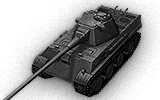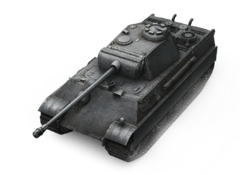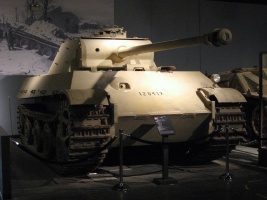Panther II
Panther_II (Stock)
| 2390000 Cost |
| 1350 HPDurability |
| 52.43 / 56 Weight |
- Commander
- Gunner
- Driver
- Radio Operator
- Loader
| 100/60/40Hull Armor(front/sides/rear, mm) |
| 100/45/45Turret Armor(front/sides/rear, mm) |
| 650 h.p.Engine Power |
| 55 km/hTop Speed / Reverse Speed |
| 40 deg/sTraverse Speed |
| 160 damage |
| 150 mmAverage Penetration |
| 5.53036944270507 Time for Complete Loading |
| 42 deg/sGun Traverse Speed |
| 260 mView Range |
| 500 mSignal Range |

A step-up in the world from the Pz.Kpfw. V Panther, it is best to understand you are still in the same role. While being more powerful and maneuverable than the Pz.Kpfw. V Panther, a M26 Pershing will definitely beat you in a close-quarters fight. Knowing this, it is best to take advantage of your long-range accuracy and stay just behind, or alongside, your team's heavies to avoid close-quarters combat. The Panther II has a higher profile than its counterparts, the M26 Pershing and the T-44, which means you are easier to spot, so position yourself on the battlefield very carefully. The Panther II is like a Pz.Kpfw. VI Tiger but one Tier higher and more mobile.


Turret
| Level | Turret | Turret Armor (front/sides/rear, mm) | Gun Traverse Speed (deg/s) | View Range (m) | Experience | Weight (t) |
|---|---|---|---|---|---|---|
| VII | Turm-Panther (schmale Blende) | 100/45/45 | 42 | 260 | 0 | 7500 |
| Level | Gun | Average Penetration (mm) | Rate of Fire | Dispersion at 100 m | Aiming Time | Experience | Weight (t) | |
|---|---|---|---|---|---|---|---|---|
| V | 10,5 cm Kw.K. L/28 | 64/104/53 | 330/330/410 | 8.02 | 0.55 | 2.5 | 4480 | 2100 |
| VI | 7,5 cm Kw.K. 42 L/70 | 150/194/20 | 160/160/200 | 10.85 | 0.35 | 2.3 | 0 | 1740 |
| VIII | 7,5 cm Kw.K. L/100 | 198/244/20 | 160/160/200 | 10.85 | 0.32 | 2.3 | 20130 | 2100 |
| Level | Turret | Turret Armor (front/sides/rear, mm) | Gun Traverse Speed (deg/s) | View Range (m) | Experience | Weight (t) |
|---|---|---|---|---|---|---|
| VIII | Panther II Schmalturm | 120/60/60 | 35 | 260 | 15100 | 7745 |
| Level | Gun | Average Penetration (mm) | Rate of Fire | Dispersion at 100 m | Aiming Time | Experience | Weight (t) | |
|---|---|---|---|---|---|---|---|---|
| V | 10,5 cm Kw.K. L/28 | 64/104/53 | 330/330/410 | 8.02 | 0.55 | 2.5 | 4480 | 2100 |
| VI | 7,5 cm Kw.K. 42 L/70 | 150/194/20 | 160/160/200 | 10.85 | 0.35 | 2.3 | 0 | 1740 |
| VII | 8,8 cm Kw.K. 36 L/56 | 145/195/44 | 220/220/270 | 9.68 | 0.38 | 1.9 | 11210 | 2050 |
| VIII | 8,8 cm Kw.K. 43 L/71 | 203/237/44 | 220/220/270 | 9.23 | 0.34 | 1.9 | 20630 | 2562 |
| VIII | 7,5 cm Kw.K. L/100 | 198/244/20 | 160/160/200 | 13.04 | 0.32 | 1.9 | 20130 | 2100 |

Engine
| Level | Engine | Engine Power (h.p.) | Chance of Fire on Impact | Experience | Weight (t) |
|---|---|---|---|---|---|
| VII | Maybach HL 210 TRM P30 | 650 | 20 | 0 | 850 |
| VIII | Maybach HL 230 TRM P30 | 700 | 20 | 15800 | 1200 |

| Level | Suspension | Load Limit | Traverse Speed (deg/s) | Experience | Weight (t) |
|---|---|---|---|---|---|
| VII | Panther II | 56 | 40 | 0 | 16500 |
| VIII | Panther II verstärkteketten | 56 | 43 | 14100 | 16500 |

Radio
| Level | Radio | Signal Range (m) | Experience | Weight (t) |
|---|---|---|---|---|
| VI | FuG7_GER | 500 | 0 | 70 |
Compatible Equipment
Compatible Consumables
Player Opinion
Pros and Cons
Pros:
- Second highest DPM of all tier 8 medium tanks
- Decenttop speed
- Decently sloped upper glacis
- Good weight for ramming
- Good penetration and damage
Cons:
- Poorly armored lower glacis plate
- Bad APCR penetration
- Poor engine power, resulting on a mediocre power to weight ratio
- Large silhouette for a medium
- Engine can get damaged or catch fire from hits to the lower glacis
Performance
The Panther II is a solid and capable tank in the right hands; understanding its strengths and weaknesses are the key to sucess. The Panther II isn't a brawler. It lacks both the speed and the agility to do so with any large amount of success. However, it can be a very successful flanker, so long as you pick and choose your targets. Sniping is always preferential in the Panther II over direct engagement, but don't discount scrapping entirely; the Panther II can take some decent hits, but only risk it if you have support. The Panther II works best in a pack, just like any other medium. Going out on your own will often result in finding yourself a smoldering wreck.
If possible, try only to expose your turret to the enemy. Like most German tanks, the lower glacis plate is a large weakness, one which smart opponents will exploit readily if given the chance. Shots through the lower glacis will often find your engine broken and often lit on fire. It may also be difficult playing the vehicle on slopes as its gun depression is lacking.
Must-have equipment for this tank are the Tank Gun Rammer and the Vertical Stabilizer to reduce reload time and drastically improve gun performance. The third equipment choice is preferential; a Gun Laying Drive will reduce aim time when stopped and help snipe more quickly, Coated Optics increase view range by 10% constantly, and Binocular Telescopes will help spot even camouflaged tanks very well, but only when the tank is stationary. Play style will determine which of these is the best for you.
Although frowned upon, the Panther II, unlike its predecessor, can play a role similar to a brawling heavy, but in a way that sets it apart from almost any other tank in the game. Use the good penetration of the Panther IIs top gun to your advantage by assassinating unwary heavily damaged opponents; heavies, mediums, whatever class they may be. Learning the weak spots of tanks and where your gun can penetrate their armor will only enhance this ability. Equipping a Tank gun Rammer and Enhanced Gun Laying drive further increases the Late-game danger this tank becomes. The Panther II and those that follow it can become extremely dangerous late-game tanks in the right hands. With an elite crew, this tank can spot farther, turn and aim faster, and with its high DPM out-gun almost any other tank in its classes tier. In essence, this tank can deceptively turn into a "Medium-Heavy" late-game in urban areas in particular. Pick off badly injured tanks, weave about through streets and alleys, use plenty of cover and outsmart your foes, keep on the lookout for newly spotted targets and eliminate them as quickly as you can and you will find yourself able to completely turn, if not help turn the tide of a battle. This sort of play is very viable in tier 8 and 9 matches, but it is best you become acquainted with your Panther IIs capabilities before attempting such a feat, and is especially not advised if you have already taken severe damage.
Early Research
The first thing to upgrade is the turret, which gives extra view range and armor and gives more improvement than the suspension. Then research the suspension, so that you can then research and mount the L/71 or L/100. The engine does not give a very large improvement to this heavy medium, so research this last.
Historical Info
In a meeting on February 10, 1943, further design changes were proposed, including changes to the steering gears and final drives. Another meeting on February 17, 1943 focused on sharing and standardizing parts between the Tiger II tank and the Panther 2, such as the transmission, all-steel roadwheels, and running gear. No plans were made to include the 8.8 cm L/71 as the turret diameter was too small. In March 1943, MAN indicated that the first prototype would be completed by August 1943. A number of engines were under consideration, among them the new Maybach HL 234 fuel-injected engine (900 hp operated by an 8-speed hydraulic transmission).
Thus, plans to replace the original Panther design with the Panther II were already underway before the first Panther had even seen combat. But, from May to June 1943, work on the Panther II ceased, as the focus was shifted to expanding production of the original Panther tank. It is not clear if there was ever an official cancellation; this may have been because the Panther II upgrade path was originally started at Hitler's insistence. The direction that the design was headed would not have been consistent with Germany's need for a mass-produced tank, which was the goal of the Reich Ministry of Armament and War Production. Additionally, many of the problems the Panther II was made to address had been resolved, such as the weak side armor.
Historical Gallery
Sources and External Links

